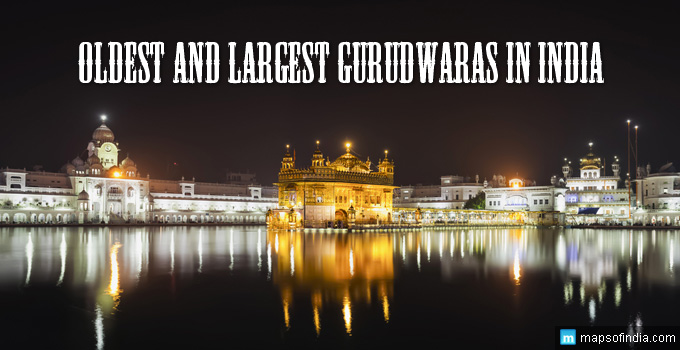Sikhism, founded by Guru Nanak Dev Ji in the 15th century, is a religion that resonates with the virtues of equality, bravery and generosity. One of the most powerful new-age religions in the history of India, Sikhism gave India some extraordinary men who were willing to sacrifice their lives for causes that symbolised the welfare of the society and truth. These men became the pillars of courage who defended the country and the society. Gurudwara, the sacred shrine of Sikhism, reflects the very foundation of the religion, where apart from spiritual comfort, one also finds the teachings of Guru Nanak Dev Ji being practiced in the form of Langars.
There are innumerable Gurudwaras in India. But the following are some of the oldest and the largest Gurudwaras of India:
Gurudwara Sri Harmandir Sahib, Punjab (Golden Temple)
Gurudwara Sri Harmandir Sahib is most famous of all Gurudwaras of India and is located in Amritsar. The foundation of this Gurudwara was laid by Guru Arjan Singh, the 5th Guru of Sikhism, in 1588. The Adi Granth, the Holy Scripture of the Sikhs with the teachings of Guru Nanak Dev Ji, was established in the Gurudwara in 1604 by Guru Arjan Singh. In 19th century, in order to protect this shrine, Maharaja Ranjit Singh covered the upper floors with sheets of Gold, giving the Gurudwara the name Golden Temple. The Gurudwara has a museum showcasing the rich past of Sikhs like events, saints, martyrs and includes commemorative inscriptions of all the Sikh soldiers who died in World War I and II. The Langar of Golden Temple feeds thousands of people, poor and rich, every day.
Takht Sri Patna Sahib, Bihar
Believed to be the birthplace of Guru Gobind Singh Ji, Takht Sri Patna Sahib is one of the most important Gurudwaras of India. Guru Gobind Singh, the 10th and the last living Guru of Sikhism, spent many years in Patna, and this temple was built in his remembrance by Maharaja Ranjit Singh in 1780. Besides being the birthplace of Guru Gobind Singh ji, Patna Sahib is also of great significance for the Sikhs from around the world because Guru Teg Bahadur has also visited Patna and stayed in the same place.
Gurudwara Bangla Sahib, New Delhi
Gurudwara Bangla Sahib is located in the heart of Delhi and is one of the most important landmarks of the capital city of India. This sacred edifice was built between the 17th and the 18th century. It was initially a bungalow, owned by Maharaja Jai Singh. The eighth Sikh Guru Har Krishan had stayed in this abode in 1664 when Delhi was ravaged by chicken pox and cholera epidemic, and true to the teachings of Sikhism had helped the people by giving them clean water from the nearby well. However, Guru Har Krishan also contracted the illness and died here. Maharaja Jai Singh converted the bungalow into a Gurdwara in the 18th Century to commemorate the stay of Guru Har Krishan and his noble deeds. He built a tank over the well from which the Guru gave water to the sick. It is believed that the water from this tank has healing properties.
Gurudwara Sri Hemkunt Sahib, Uttarakhand
This Gurudwara, situated in Chamoli district of Uttarakhand at an altitude of more than 4000 mts above sea level, is dedicated to the tenth Sikh Guru, Guru Gobind Singh Ji. The architecture of this Gurudwara has been designed keeping in view the prevailing weather and the altitude of the place. This Gurudwara finds mention in Dasam Granth, a work dictated by Guru Gobind Singh Ji. It is located on a glacial lake surrounded by seven mountain peaks, each adorned by a Nishan Sahib on its cliff and indeed redefines spirituality.
Takhat Sachkhand Shri Hazur Abchalnagar Sahib Gurudwara, Maharashtra
Takhts are the five temporal authorities of Sikhism symbolised by five Gurudwaras and have a very special significance for the Sikh community. Believed to be one of the five takhts in Sikhism, Takhat Sachkhand Shri Huzur Abchalnagar Sahib Gurudwara is situated in Nanded. The 10th Sikh guru, Guru Gobind Singh, breathed his last in Nanded and Maharaja Ranjit Singh constructed a Gurudwara at this place in 1832, which is highly revered in the Sikh community. The complex inside is called Sachkhand or the Realm of Truth and the room inside the Gurudwara, where it is believed that Guru Gobind Singh breathed his last, is called Angitha Sahib.
Related Information :
Jallianwala Bagh Massacre: Story, History, Facts, Why it Happened





